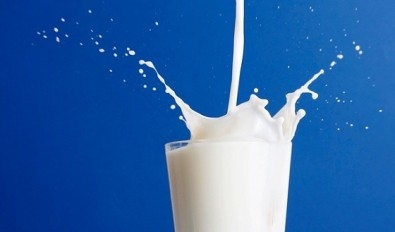

Experiments with mice show that whey protein shields intestinal microbiota from unhealthy effects of fatty foods (photo: Wikimedia Commons)
Experiments with mice show that whey protein shields intestinal microbiota from unhealthy effects of fatty foods
Experiments with mice show that whey protein shields intestinal microbiota from unhealthy effects of fatty foods

Experiments with mice show that whey protein shields intestinal microbiota from unhealthy effects of fatty foods (photo: Wikimedia Commons)
By Diego Freire | Agência FAPESP – In addition to its importance to athletes, bodybuilders and fitness enthusiasts, whey protein is also important for the protection it affords against the adverse effects of a high-fat diet on intestinal microbiota, according to researchers at the University of Campinas’s Food Engineering School (FEA) and Medical School (FCM-UNICAMP) in São Paulo State, Brazil.
The researchers compared the effects of different proteins on bacterial populations in the intestines of mice. The study was performed as part of the FAPESP-supported project entitled “Metabolic impact of dietary whey proteins, peptides and amino acids thereof on heat-shock proteins (HSPs) and associated parameters in rats”.
“It was already well known that different amounts and types of fat intake change in different ways the composition of the populations of microorganisms that inhabit animals’ intestines, predisposing the host to inflammatory processes that can lead to obesity and other chronic disorders. What wasn’t known was which dietary proteins play a key role in terms of allowing or resisting changes to the intestinal microbiota,” said Jaime Amaya Farfan, a researcher at FEA-UNICAMP’s Food & Nutrition Department.
The study showed that casein, another dairy protein that is digested and absorbed slowly, permitted disruption of normal gut microbiota when consumed as part of a high-fat diet, whereas the consumption of whey protein enabled the laboratory animals to resist this effect.
The main alterations induced by consumption of too much fat include an inversion in the predominance of two bacterial phyla typically found in the intestine: Bacteroidetes, the most abundant phylum in normal microbiota, and Firmicutes, which is predominant in obese animals.
The researchers found that mice fed a high-fat diet that included casein-rich foods such as cheese for nine weeks exhibited increased blood lipopolysaccharides, which are molecules associated with the development of chronic intestinal disorders, fatty liver disease (hepatic steatosis) and inversion in the quantity of predominant bacterial phyla favoring Firmicutes. By contrast, when the high-fat diet was administered together with whey protein, the levels of lipopolysaccharides and biomarkers of inflammation, as well as fatty liver disease, remained significantly low, preventing phyla inversion.
“This contrast between the effects of the two main classes of milk protein, casein and whey, was a surprise, but it can be explained as resulting from the formation of different peptides that are typical of each protein during digestion,” Farfan said. “In the case of whey protein, previous research performed at our Food Engineering School showed that it contains certain peptides with properties that include increased capture of glucose by muscle cells, increased expression of anti-stress proteins in rodents, and possibly protection against muscle microlesions in soccer players undergoing intense training.”
For the sake of comparison, other mice were fed a high-fat diet plus hydrolyzed whey, in which peptide bonds in the protein’s amino acids are broken down into short-chain fragments by hydrolysis to facilitate absorption in the intestine.
The results showed that although hydrolyzed whey also prevented a drastic increase in blood lipopolysaccharides, rapidly rising systemic inflammation and a buildup of excess liver fat, it did not prevent the intestinal predominance of Firmicutes, although Bacteroidetes did not decrease as much as in mice fed the casein-rich diet.
“These findings give rise to a suspicion that excessive reduction of Bacteroidetes rather than mere inversion of the two main phyla is a more significant factor leading to the harmful effects of a high-fat diet,” Farfan said. Bacteria of the phylum Bacteroidetes are a potential endogenous source of pro-inflammatory lipopolysaccharides that may enter the blood stream.
From fitness center to snack bar
According to Farfan, “the study contributes to a deeper understanding of the properties of the various proteins in our diet, and hence of the differences between them. While they can be grouped generically in the same class of nutrients, their effects on health can’t be estimated simply by adding together the nutritional value of their amino acids.”
If studies of humans produce the same results, he went on, they should be considered a warning not to consume excessive amounts of cheese with other fatty foods, for example.
“A cheese and mortadella sandwich is unhealthy because cheese is rich in casein and mortadella contains a lot of pork fat,” Farfan said. “What the study with mice shows is that unlike ricotta, which is rich in whey protein, ordinary cheese doesn’t protect normal intestinal microbiota against the alterations caused by too much fat.”
In short, ricotta is made from whey and would be a better companion for mortadella in the sandwiches served by snack bars.
The results of the study are described in an article entitled “Dietary whey proteins shield murine cecal microbiota from extensive disarray caused by a high-fat diet” by Jaime Amaya Farfan, Naice Eleidiane Santana Monteiro, Aline Rissetti Roquetto, Fernanda de Pace, Carolina Santos Moura, Andrey dos Santos, Áureo Tatsumi Yamada and Mário José Abdalla Saad and published in Food Research International, available at www.sciencedirect.com/science/article/pii/S096399691630179X .
Republish
The Agency FAPESP licenses news via Creative Commons (CC-BY-NC-ND) so that they can be republished free of charge and in a simple way by other digital or printed vehicles. Agência FAPESP must be credited as the source of the content being republished and the name of the reporter (if any) must be attributed. Using the HMTL button below allows compliance with these rules, detailed in Digital Republishing Policy FAPESP.





